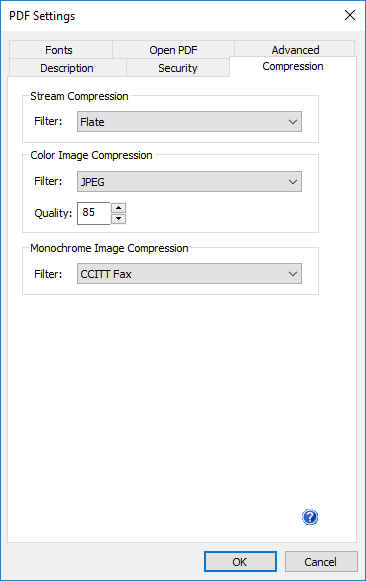
Under the compression tab you can select the compression algorithm of the PDF document’s content.Using compression will reduce the size of the output file. Compression method uses a formula or algorithm to determine to compress data. This algorithm determines the compression quality.
A compression algorithm can be as simple as removing all extra space characters, inserting a single repeat character to indicate a string of repeated characters, and substituting smaller bit strings for frequently occurring characters. Even this kind of compression can reduce a text file to 50% of its original size.
Compression can be either lossy (some information is permanently lost) or lossless (all information can be restored).

Black Ice Printer Drivers provide the following compression methods:
Stream Compression Filter - Compression type of the non-image streams.
Color Image Compression - Compression type of color image streams.
Quality - Quality of the JPEG compressed images (available values from 1 to 100, where 100 is the best quality).
Monochrome Image Compression - Compression types of black-and-white image streams.
None - no compression algorithm is used.
Flate is a lossless compression method. Flate works well on images with large areas of single colors or repeating patterns.
Run Length Encoding (RLE) is also a lossless compression option that produces the best results for images that contain large areas of solid white or black.
JPEG is a lossy compression algorithm that has been conceived to reduce the file size of natural, photographic-like true-color images as much as possible without affecting the quality of the image as experienced by the human eye and nervous system. JPEG is suitable for grayscale or color images. Because JPEG eliminates data, it can achieve much smaller file sizes than other lossless compression methods.
JPEG Loss Ratio - The quality of the JPEG file that is generated. A higher value equals higher quality; however, the file size is larger. Conversely, a lower value equals lower quality, but the file size is smaller.
CCITT Fax is also a lossless compression option. CCITT stands for International Coordinating Committee for Telephony and Telegraphy. CCITT Fax compression is the appropriate compression method for black-and-white images made by paint programs and any images scanned with an image depth of 1 bit.
LZW Compression (Lempel–Ziv–Welch) is a universal lossless data compression algorithm. LZW compression became the first widely used universal data compression method on computers. A large English text file can typically be compressed via LZW to about half its original size. LZW became very widely used when it became part of the GIF image format, and it is also used in TIFF and PDF files.